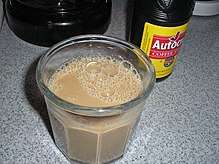List of coffee drinks
Coffee drinks are made by brewing hot water and occasionally cold water with ground coffee beans. The brewing is either done slowly by drip, filter, French press, cafetière or percolator, or done very quickly under pressure by an espresso machine. When put under the pressure of an espresso machine, the coffee is termed "espresso" while slow-brewed coffees are generally called "coffee." While all coffee drinks are based on either coffee or espresso, some drinks have milk or cream added, some use steamed milk, cream, plant based milk, or foamed milk. Some even have flavorings or sweeteners, some have alcoholic liqueurs added, some are combinations of coffee with espresso or tea.[1] There are many variations to the basic coffee or espresso bases.
With the invention of the Gaggia machine, espresso, and espresso with milk such as cappuccino and latte, spread in popularity from Italy to the UK in the 1950s. It then came to America, and with the rise in popularity of the Italian coffee culture in the 1980s it began to spread worldwide via coffeehouses and coffeehouse chains.[2][3]
The caffeine content in coffee beans may be reduced via one of several decaffeination processes to produce decaffeinated coffee, also known as "decaf" coffee, which may be served as regular, espresso or instant coffee.
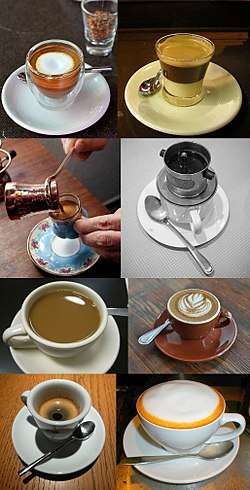
Infused
Drip or filtered
Drip-brewed, or filtered coffee, is brewed by hot water passing slowly over roasted, ground coffee beans contained in a filter. Water seeps through the ground coffee, absorbing its oils, flavours and essences, solely under gravity, then passes through the bottom of the filter. The used coffee grounds are retained in the filter with the liquid dripping into a collecting vessel such as a carafe or pot.
Paper coffee filters were invented in Germany by Melitta Bentz in 1908.[4] To reduce waste, some coffee drinkers use fine wire mesh filters, which can be re-used for years. Many countries in Latin America and Africa traditionally prepare drip coffee using a small reusable bag made of cotton or other cloth.
French press or cafetière
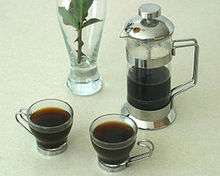
A French press, also known as a press pot, coffee press, coffee plunger, cafetière (UK) or cafetière à piston, is a coffee brewing device patented by Italian designer Attilio Calimani in 1929.[5] A French press requires a coarser grind of coffee than a drip brew coffee filter, as finer grounds will seep through the press filter and into the coffee.[6]
Coffee in a French press is brewed by placing the ground coffee in the empty beaker and adding hot (93-96 degrees Celsius, 200-205 degrees Fahrenheit) water, in proportions of about 28 grams (1 ounce) of coffee to 450 ml (15 fluid ounces) of water, more or less to taste. After approximately four minutes the plunger is pressed to separate the grounds and hold them at the bottom of the beaker, then the coffee is poured.[7] Coffee press users have different preferences for how long to wait before pressing the plunger, with some enthusiasts preferring to wait longer than four minutes.
Cold brew

Cold brewing, also called cold water extraction or cold pressing, is the process of steeping coffee grounds in water at cool temperatures for an extended period. Coarse-ground beans are soaked in water for about 12 to 24 hours.[8][9]
The water is normally kept at room temperature, but chilled water can also be used. After the grounds have been steeped, they are filtered out of the water using a paper coffee filter, a fine metal sieve, a French press, or felt. The result is a coffee concentrate that is diluted with water or milk, and is even sometimes served hot, but often served chilled, or over ice, or blended with ice and other ingredients such as chocolate.[10]
Cold brew coffee originated in Japan, where it has been a traditional method of coffee brewing for centuries.[11] Slow-drip cold brew, also known as Kyoto-style, or as Dutch coffee in East Asia (after the name of coffee essences brought to Asia by the Dutch),[12] refers to a process in which water is dripped through coffee grounds at room temperature over the course of many hours.[13] Cold brew can be infused with nitrogen to make nitro cold brew coffee.
Because the ground coffee beans in cold-brewed coffee never come into contact with heated water, the process of leaching flavor from the beans produces a chemical profile different from conventional brewing methods.[14][15] Coffee beans contain a number of parts that are more soluble at higher temperatures, such as caffeine, oils and fatty acids. However brewing at a lower temperature for 24 hours results in higher caffeine content when brewed in equal volume compared to 6 minutes at 98 °C.[16] The pH of cold and hot brew coffee is similar but cold brew coffee has a lower titratable acid concentration.[17] Both pH and titratable acidity influence taste.[18]
Boiled
Percolated
A coffee percolator is a type of pot used to brew coffee by continually cycling the boiling water through the grounds using gravity until the required coffee strength is reached. There are stove-top percolators and standalone units which contain a built-in heating element. Percolators were popular until the 1970s, when they were widely replaced by drip coffee makers. By the mid-1970s, many companies ceased production of percolators.
Turkish coffee

Beans for Turkish coffee are ground to a fine powder. Turkish coffee is prepared by immersing the coffee grounds in water and heating until it just boils. This method produces the maximum amount of foam. If the coffee is left to boil longer, less foam remains. In Turkey, four degrees of sweetness are used. The Turkish terms and approximate amounts are as follows: sade (plain; no sugar), az şekerli (little sugar; half a level teaspoon of sugar), orta şekerli (medium sugar; one level teaspoon), çok şekerli (a lot of sugar). Before boiling, the coffee and the desired amount of sugar are stirred until all coffee sinks and the sugar is dissolved.
Turkish coffee is an Intangible Cultural Heritage of Turkey confirmed by UNESCO.[19]
Moka
Moka coffee is coffee brewed with a moka pot, a stovetop coffee maker which produces coffee by passing hot water pressurized by steam through ground coffee at a lower pressure than an espresso maker. The moka pot is an Italian invention, first produced by Bialetti in the early 1930s. The flavor of moka pot coffee depends greatly on bean variety, roast level, fineness of grind, and the level of heat used. Due to the higher-than-atmospheric pressure involved, the mixture of water and steam reaches temperatures well above 100 °C, causing a more efficient extraction of caffeine and flavors from the grounds, and resulting in a stronger brew than that obtained by drip brewing.
Vacuum coffee
A vacuum coffee maker brews coffee using two chambers where vapor pressure and vacuum produce coffee. This type of coffee maker is also known as vac pot, siphon or syphon coffee maker, and was invented by Loeff of Berlin in the 1830s. These devices have since been used for more than a century in many parts of the world and more recently have been given a new use by bartenders and chefs to make hot cocktails and broths.[20]
Espresso
Espresso is brewed by using an espresso machine to force a small amount of nearly boiling water and steam – about 86 to 95 °C (187 to 203 °F) – under pressure through finely ground and compacted coffee.[21][22] The espresso machine was patented in 1901 from an earlier 1884 machine,[23][24] and developed in Italy; with the invention of the Gaggia machine, espresso spread in popularity to the UK in the 1950s where it was more often drunk with milk as cappuccino due to the influence of the British milk bars,[25][26][3] then America in the 1980s where again it was mainly drunk with milk,[3] and then via coffeehouse chains it spread worldwide.[3] Espresso is generally denser than coffee brewed by other methods, having a higher concentration of suspended and dissolved solids; it generally has a creamy foam on top termed "crema".[27] Espresso is the base for a number of other coffee drinks, such as latte, cappuccino, macchiato, mocha, and Americano.[28]
- Caffè Americano
.jpg)
Caffè Americano or simply Americano (the name is also spelled with varying capitalization and use of diacritics: e.g. Café Americano, Cafe Americano, etc.) is a style of coffee prepared by adding hot water to espresso, giving a similar strength to but different flavor from brewed coffee. The drink consists of a single or double-shot of espresso combined with between 1 and 16 fluid ounces (30–470 ml) of hot water. The strength of an Americano varies with the number of shots of espresso added. In the United States, "Americano" is used broadly to mean combining hot water and espresso in either order. Variations include long black and lungo.
- Caffè Lungo
The caffè lungo (or allongé in French) is similar to a Caffè Americano or a long black. However, instead of adding water to an espresso, all the water is brewed. The lungo is generally smaller than an Americano or a long black.
- Manilo
A Manilo coffee consists of a regular espresso shot and less than 100ml of silky milk. Popularised due to its strength and taste, without a lot of milk. Similar to a half flat white, but slightly smaller.
- Café Cubano
Cuban tradition is to drink coffee strong and sweet, often mixing the sugar with the coffee beans before brewing. The traditional method of brewing coffee was a filter method using a cloth cone; this has mostly been replaced with an aluminium cafetera or coffeemaker—in tourist areas some cafés will have an espresso machine, though espresso machines are expensive, so espresso is not a common drink for most Cubans.[29][30] Though quality coffee is grown in Cuba, it is expensive, so most Cubans drink coffee imported from Puerto Rico, and often mixed with ground peas.[31][32] The Cuban habit of brewing coffee with sugar has spread to Miami, West Palm Beach, Tampa and the Keys, in Florida, US, where espresso is the preferred brewing method and an espresso brewed with sugar is termed Café Cubano, Cuban coffee, Cuban espresso, cafecito, Cuban pull, or Cuban shot.[33] Sometimes demerara sugar is used, and sometimes the sugar (white or brown) is not brewed with the coffee, but is placed in the cup as the coffee is dripped into it, then stirred into a froth.[34][35] Variations on the Miami café Cubano are with a splash of milk - cortadito; and with steamed milk - café con leche.[36]
- Caffè crema
Caffè crema (Italian: cream coffee) refers to two different coffee drinks:[37] an old name for espresso (the 1940s and 1950s), and a long espresso drink primarily served in Germany, Switzerland and Austria and northern Italy (the 1980s onwards), along the Italian/ Swiss and Italian/ Austrian border.[38] As a term, it generally means "espresso", while in technical discussions, referring to the long drink, it may more narrowly be referred to as Swiss caffè crema. Variant terms include "crema caffè" and the hyperforeignism "café crema" – "café" is French, while "caffè" and "crema" are Italian, thus "café crema" mixes French and Italian.
- Cafe Zorro
A Cafe Zorro is a double espresso or doppio, added to hot water with a 1:1 ratio.
- Doppio
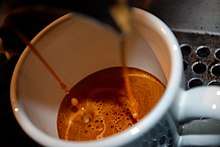
Doppio is a double shot, served in a demitasse cup.[39]
- Espresso Roberto
An espresso Roberto is a double shot espresso with a small amount of steamed milk on the side. Made properly a splash of steamed whole milk is added.
- Espresso Romano
An espresso Romano is a shot of espresso with a slice of lemon served on the side. The lemon can be run along the rim of the cup as a way to accentuate the espresso's sweetness.[40] Despite the name, it has no link to Italy nor Rome.
- Guillermo
Originally one or two shots of hot espresso poured over slices of lime. It can also be served on ice, sometimes with a touch of milk.
- Ristretto
Ristretto is traditionally a short shot of espresso made with the normal amount of ground coffee but extracted with about half the amount of water. Since ristrettos are essentially the first half of a full-length extraction, the faster-to-extract compounds predominate in a ristretto. The opposite of a ristretto is a lungo, which is typically double the shot volume. Ristretto means “limited” or “restricted” in Italian whereas lungo means “long.”
Straight ristrettos—shots that are traditionally drunk from a demitasse and not diluted into a larger cup containing milk or water—could be described as bolder, fuller, with more body, and less bitterness, but with a higher concentration of acidity. These characteristics are usually attributed to espresso in general but are more pronounced in a ristretto. Diluted into a cup of water (to make an Americano or long black) or milk (e.g. latte and cappuccino), ristrettos are less bitter and exhibit a more intense espresso character.[41]
Combinations
Coffee with milk
Coffee with condensed milk
Café bombón was made popular in Valencia, Spain, and spread gradually to the rest of the country. It might have been re-created and modified to suit European tastebuds as in many parts of Asia such as Malaysia, Thailand and Singapore. The same recipe for coffee which is called "Kopi Susu Panas" (Malaysia) or "Gafeh Rorn" [lit: hot coffee] (Thailand) has already been around for decades and is very popular in "mamak" stalls and "kopitiams" in Malaysia. A café bombón, however, uses espresso served with sweetened condensed milk in a 1:1 ratio whereas the Asian version uses ground coffee and sweetened condensed milk at the same ratio. On the Canary Islands a variety named "Café Proprio" or "Largo Condensada" is served using the same amount of condensed milk but a "café largo" or espresso lungo. For café bombón, the condensed milk is added to the espresso. For visual effect, a glass is used, and the condensed milk is added slowly to sink underneath the coffee and create two separate bands of contrasting colour – though these layers are customarily stirred together before consumption. Some establishments merely serve an espresso with a sachet of condensed milk for patrons to make themselves.
Coffee with espresso
Regular coffee (slow brewed as with a filter or cafetière) is sometimes combined with espresso to increase either the intensity of the flavour or the caffeine content.[42] This may be called a variety of names, most commonly "red eye,"[43] "shot in the dark,"[44][45] and "depth charge" – though this last is a federally registered trademark of a company, Caribou Coffee, so its usage is restricted.[46] Coffeehouse chains may have their own names, such as "turbo" at Dunkin' Donuts.[47] A double shot of espresso in the coffee may be termed a "black eye," and a triple shot a "dead eye." "Caffè Tobio" is a version with an equal amount of coffee to espresso.[48]
Coffee with tea
- Black tie is a drink made by mixing traditional Thai iced tea, which is a spicy and sweet mixture of chilled black tea, orange blossom water, star anise, crushed tamarind, sugar and condensed milk or cream, with a double shot of espresso.
- Numerous houses use the term chai latte to indicate that the steamed milk of a normal caffè latte is being flavoured with a spiced tea concentrate instead of with espresso. Add espresso shots for a dirty chai latte. Chai tea with a single shot of espresso. In addition, 1-2 tablespoons of instant espresso may be brewed while simultaneously steeping chai in the same container; a small amount of a dairy or non-dairy drink of choice is usually added to complete the drink.
- Red tie is a drink made by mixing traditional Thai iced tea, which is a spicy and sweet mixture of chilled black tea, orange blossom water, star anise, crushed tamarind, sugar and condensed milk or cream, with a single shot of espresso.
- Yuenyeung (drink) is a popular drink in Hong Kong, made of a mixture of coffee and Hong Kong-style milk tea. It was originally served at dai pai dangs (open space food vendors) and cha chaan tengs (cafe), but is now available in various types of restaurants. It can be served hot or cold. The name yuanyang, which refers to mandarin ducks, is a symbol of conjugal love in Chinese culture, as the birds usually appear in pairs and the male and female look very different. This same connotation of "pair" of two unlike items is used to name this drink.
Coffee with alcohol
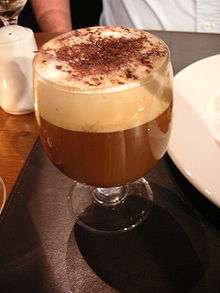
A liqueur coffee, as its name suggests, is a coffee brew with a 25 ml shot of liqueur. This brew is usually served in a clear liqueur coffee glass with the coffee and cream separated for visual and taste effect. The liqueur of choice is added first with a teaspoon of sugar mixed in. The glass is then filled to within an inch of the top with filtered coffee. Slightly whipped cream may then be poured over the back of a spoon, so that it floats on top of the coffee and liqueur mixture. The sugar is required in the coffee mixture to help the cream float.
- Irish Coffee (Irish Whiskey)
- Caffè corretto (that is an Italian drink, consists of a shot of espresso "corrected" with a shot of liquor, usually grappa, brandy or sambuca.)
- Coffee liqueurs (many brands)
- Karsk, kaffegök or svartkopp (coffee with moonshine)
- Rüdesheimer Kaffee is an alcoholic coffee drink from Rüdesheim in Germany invented in 1957 by Hans Karl Adam. It is made with Asbach Uralt brandy with coffee and sugar, and is topped with whipped cream.
- A Pharisäer (Danish: farisæer), meaning a Pharisee, is an alcoholic coffee drink that is popular in the Nordfriesland district of Germany. It consists of a mug of black coffee, a double shot of rum, and a topping of whipped cream. In 1981, a court in Flensburg ruled that 2 centilitres (0.70 imp fl oz; 0.68 US fl oz) of rum were not sufficient for preparing a genuine Pharisäer.[49]
- Barraquito is an old drink from Tenerife combining espresso, condensed sweetened milk, foamed milk, lemon, cinnamon and Licor 43, which was carried across the Atlantic in a later modified form as the Carajillo.
- A Carajillo is a Spanish drink combining coffee with brandy, whisky, anisette, or rum. It is typical of Spain and according to folk etymology, its origin dates to the Spanish occupation of Cuba. The troops combined coffee with rum to give them courage (coraje in Spanish, hence "corajillo" and more recently "carajillo"). There are many different ways of making a carajillo, ranging from black coffee with the spirit simply poured in to heating the spirit with lemon, sugar and cinnamon and adding the coffee last. A similar Italian drink is known as caffè corretto. The American version of a Spanish Coffee uses a heated sugar-rimmed Spanish coffee mug with 3/4 ounce of rum and 1/2 ounce of triple sec. The drink is then flamed to caramelize the sugar, with 2 ounces of coffee liqueur then added to put out the flame, and then topped off with 3 to 4 ounces of coffee, and whipped cream.
- Gunfire (drink) has its origins in the British Army, typically made by mixing black tea with rum, though in Australia and New Zealand it is more often made with black coffee instead. On ANZAC Day, this version is served to soldiers before dawn services as part of the "gunfire breakfast".
The caffeine content of these coffee drinks, to the extent that caffeine is present in them, will not prevent intoxication from their alcohol content. Instead, the caffeine may mask the true degree of ethanol-induced loss of coordination.
Flavoured
- Melya
Melya is coffee flavoured with cocoa powder and honey.[50] Cream is sometimes added.[50]
- Caffè Marocchino
The Marocchino is made from espresso, steamed milk, and a dusting of cocoa powder, similar to the espressino.
- Café miel
A café miel has a shot of espresso, steamed milk, cinnamon, and honey. The name comes from the French word for honey, miel.
- Mocha or café mocha or mochaccino
A café mocha is a variant of a caffè latte. Like a latte, it is typically one third espresso and two thirds steamed milk, but a portion of chocolate is added, typically in the form of a chocolate syrup, although other vending systems use instant chocolate powder. Mochas can contain dark or milk chocolate.
The term moccaccino is used in some regions of Europe and the Middle East to describe caffè latte with cocoa or chocolate. In the U.S. it usually refers to a cappuccino made with chocolate.
A "cafe borgia" is a mocha with orange rind and sometimes orange flavoring added. Often served with whipped cream and topped with cinnamon.
- Café de olla
Café de olla or pot coffee is a traditional coffee-based drink prepared using earthen clay pots or jars in Mexico and other Latin American countries. It is flavored with cinnamon and piloncillo. Consumed primarily in colder weathers, usually with the merienda meal, and accompanied with pan dulce pastries.
- Café Rápido y Sucio
A Café Rápido y Sucio or a Quick & Dirty Coffee, is simply three shots of espresso topped with chocolate or mocha syrup. Unlike a café mocha which has milk added or an Americano which has water added, a Café Rápido y Sucio or a Quick & Dirty Coffee is espresso and chocolate only. Any variation of this drink containing more than three shots of espresso would be referred to as a Fast & Filthy Coffee.
'Two Guys Praline coffee' which is a creation of the short lived Two Guys from Brussels café in Bangor, Gwynedd. It's one part espresso over a Belgian Praline chocolate, two parts steamed milk and 12ml of sweetened condensed milk.
- Miscellaneous
Some coffeehouses provide flavoured syrups which customers can have added to their coffee drinks. Some non-dairy creamers have flavoured versions, such as hazelnut flavour and Irish Cream flavour (the latter is non-alcoholic).
Iced
Frappé

Greek frappé (Café frappé) (Greek: φραπές), sometimes called a javaccino[51][52][53] by independent coffeehouses, is a foam-covered iced coffee drink made from spray-dried instant coffee. It is very popular in Greece especially during summer, but has now spread on to other countries.
There are numerous ways in which this coffee can be tailored to the individual's taste such as: all water-no milk; half-half; all milk and; varying levels of sweetness. Frappe is also extremely popular in the country of Cyprus where fresh milk is used as opposed to condensed. In French, when describing a drink, the word frappé means shaken or chilled; however, in popular Greek culture, the word frappé is predominantly taken to refer to the shaking associated with the preparation of a café frappé.
Greek Freddo preparations
Freddo Espresso
Freddo Espresso is a foam-covered iced coffee made from espresso. It is found in every café and coffee shop in Greece. It is undoubtedly popular among the young people during summer, or on hot days. Because of the very hot summers in Greece, and the need to escape from the heat, people began to make cold variations of the popular coffee styles. It consists of two shots of espresso (30-50 ml), sugar, and ice (60-100 ml) 1:2 ( espresso shots:ice). The espresso is mixed with the sugar in a frapièra (a drink mixer). The frapiera mixes the coffee with the sugar, producing a foam from the oils of espresso, and lowers the temperature. The coffee is then poured over ice into its serving glass. The melting of the ice cubes dilutes the coffee and results in a desirable level of bitterness and strength.
Freddo Cappuccino
Freddo Cappuccino is another variation of the original cappuccino. It is as popular as the freddo espresso. It follows the same process as the freddo espresso, but at the end foamed and creamed milk is added in ratio 1:2 (espresso shots:milk), and 1:2 ( espresso shots:ice). Recently the Coffee Island coffee shop (a coffee shop franchise in Greece), established a new foam and cream trend in freddo cappuccino. They use plant based milk creamed in the frapièra. The result is a stiffer and sweeter cream.
Other
- Mazagran
Mazagran (sometimes misspelled as Mazagrin) is a cold coffee drink that originated in Algeria. It is typically served in a tall glass, and is made with coffee and ice. Sometimes sugar, rum, lemon or water is added. Sometimes a fast version is achieved by pouring a previously sweetened espresso in a cup with ice cubes and a slice of lemon.
- Palazzo
A Palazzo is an iced coffee variant, popular in Southern California. It is two shots of espresso, chilled immediately after brewing and mixed with sweetened cream. A Palazzo is typically made using a moka pot.
- Ice Shot
Originating in Australia and similar to the Mazagran, the minimal Ice Shot is a single shot of fresh espresso poured into an ordinary latté glass that has been filled with ice. The hot coffee, in melting some of the ice is diluted, re-freezing to a granita-like texture. The addition of a single scoop of ice-cream on top is a popular variant. No milk, sugar, extra flavouring or cream are involved.
- Shakerato
Shakerato is an iced coffee made by shaking espresso and ice cubes.
Instant coffee
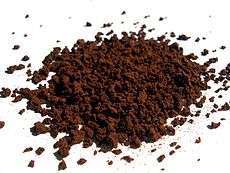
Instant coffee is a drink derived from brewed coffee beans. Through various manufacturing processes the coffee is dehydrated into the form of powder or granules. These can be rehydrated with hot water to provide a drink similar (though not identical) to conventional coffee. At least one brand of instant coffee, "Camp Coffee," is also available in concentrated liquid form.
Instant coffee brands include:
Decaffeination of coffee
A decaffeination process removes caffeine from coffee beans to lower their caffeine content.[54] Four main methods are used to extract caffeine from coffee beans:
- The so-called "Swiss" water method, so called from allegedly having been developed in Switzerland, where the beans are soaked in water;
- the ethyl acetate method, where the beans are washed in a solution of water and ethyl acetate;
- the carbon dioxide method, where either liquid or "supercritical" (between liquid and gas) carbon dioxide is applied to the beans at high pressure; or
- the dichloromethane method, where dichloromethane, a solvent, is used to dissolve the caffeine.[55]
Decaffeinated coffee grew in popularity over the last half of the 20th century, mainly due to health concerns that arose regarding the over-consumption of caffeine.[56][57][58] Decaffeinated coffee, sometimes known as "decaf," may be drunk as regular brewed coffee, instant, espresso, or as a mix of regular caffeine beans and decaffeinated beans.[59][60]
Other
Affogato
An affogato (Italian for "drowned") is a coffee-based dessert. "Affogato style", which refers to the act of topping a drink or dessert with espresso, may also incorporate caramel sauce or chocolate sauce. When ordered, an Affogato tends to be served with scoops of ice cream with a shot (or 2) of espresso poured over the top, sometimes mixed with a liqueur. A white Affogato is the same as a regular Affogato, just with milk added.
Caffè Medici
A Caffè Medici is a doppio poured over chocolate syrup and orange peel, usually topped with whipped cream. The drink originated at Seattle's historic Last Exit on Brooklyn coffeehouse.[61]
Café Touba
Café Touba is the spiritual drink of Senegal, named after Cheikh Ahmadou Bamba Mbacké (known as Serigne Touba) and the holy city of Touba in Senegal.[62] During the roasting process, the coffee beans are mixed with grains of selim, and sometimes other spices, and ground into powder after roasting.[62] The drink is prepared using a filter, similar to plain coffee. Sugar is often added before drinking.[62]
Canned coffee
Canned coffee is ubiquitous in Japan, with a large number of companies competing fiercely and offering various types for sale. Canned coffee is already brewed and ready to drink. It is available in supermarkets and convenience stores,[63] with vast numbers of cans being sold in vending machines[64] that offer heated cans in the autumn and winter,[65] and cold cans in the warm months.
Brands of canned coffee include these:
Coffee milk
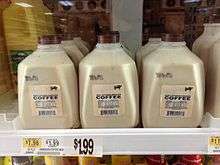

Coffee milk is sold in two ways: prepared coffee milk and coffee syrup. It is a drink prepared or made by adding a sweetened coffee concentrate called coffee syrup to milk in a manner similar to chocolate milk. It is the official state drink of Rhode Island in the United States.[66]
Coffee milk brands include:
Double Double
The "double-double" is a uniquely Canadian term that is strongly associated with Tim Hortons. It consists of a cup of drip coffee with two creams and two sugars (or double cream, double sugar). The Double-Double coffee will taste exactly the same in any cup size, from the small 10oz cup to the extra large 24oz cup. The chain achieves flavor consistency across cup sizes by employing a pair of countertop vending machines, one dispensing cream and the other dispensing sugar, with a button for each of the four cup sizes. The name "double-double" refers to the number of shots of each added, that is, two shots of cream and two shots of sugar. The terms "single-single" or "regular" and "triple-triple", though not as common as the "double-double", refer to coffee with one shot of sugar and cream and coffee with three shots of sugar and cream, respectively. The machines are calibrated regularly to ensure they dispense a perfect shot of cream or sugar to exacting specifications. The coffee is always poured over the cream and sugar, important to achieve the correct flavor. It is brewed using the pour-over drip brewing method and the coffee maker used is manufactured by Bunn-o-Matic Corporation.
Indian filter coffee
South Indian Coffee, also known as Mysore Filter Coffee or Kaapi (South Indian phonetic rendering of "coffee') is a sweet milky coffee made from dark roasted coffee beans (70%–80%) and chicory (20%–30%), especially popular in the southern states of Andhra Pradesh, Karnataka, Kerala and Tamil Nadu. The most commonly used coffee beans are Koffeey Arabica (Coffee Arabica grown from Arehalli Village) Peaberry (preferred), Arabica, Malabar and Robusta grown in the hills of Karnataka (Kodagu, Chikkamagaluru), Kerala (Malabar region) and Tamil Nadu (Nilgiris District, Yercaud and Kodaikanal).
Pocillo
A shot or small portion of unsweetened coffee, now usually made either using an espresso machine or a moka pot, but traditionally made using a cloth drip, usually served in cups made for the purpose, called "tacitas de pocillo." It is widely drunk in Latin America, usually as an afternoon or after-dinner coffee. The defining feature is the size, usually half to a quarter the size of the usual ~8 US fluid ounces (240 ml) coffee cups. There are a number of small-sized drinks that use tacitas de pocillo, including such sweetened varieties as café cubano and café cortado, but these are usually not called a pocillo; rather, the Spanish diminutive suffix "-ito" is usually added to the name of the drink wanted in a pocillo size cup. For example, a pocillo-sized cortado is usually called a cortadito.
Uovo sbattuto con caffè
Uovo sbatutto con caffè is a rustic Italian breakfast treat utilizing espresso and milk with an egg topping similar to zabaione.
See also
References
- Kate Strangfeld (25 January 2013). "Coffee, Lattes, & Macchiatos: Demystified". icingoffthecake.
- Robert W. Thurston (2013). Coffee: A Comprehensive Guide to the Bean, the Beverage, and the Industry. Rowman & Littlefield. p. 184. ISBN 9781442214422.
- Morris, Jonathan (2007). The Cappuccino Conquests: The Transnational History of Italian Coffee (Exhibition Catalogue). University of Hertfordshire.
- "The History of How We Make Coffee". About.com. Retrieved 13 February 2012.
- James Grierson, "History of the Cafetière", Coffee knowledge, UK: Galla coffee, archived from the original on 2011-11-14, retrieved 2009-12-23
- Millman, China (2009-04-23). "Freshen Up; Manual Brewing Techniques Give Coffee Lovers a Better Way to Make a Quality Drink". Pittsburgh Post-Gazette. Archived from the original on 2009-04-26. Retrieved 2009-06-16.
- "hypecoffee.com". Archived from the original on 24 September 2015. Retrieved 3 August 2015.
- "Cold Brew Coffee Brewing Guide - How To Brew Coffee - Blue Bottle Coffee". bluebottlecoffee.com. Retrieved 2018-11-14.
- "The Beginner's Guide to Immersion Cold Brew Coffee". handground.com. Retrieved 2018-11-14.
- "Cold Brew Coffee". Coffee-Brewing-Methods.com.
- Callow, Chloë (2017). Cold Brew Coffee: Techniques, Recipes & Cocktails for Coffee’s Hottest Trend. Octopus Books. ISBN 978-1-78472-368-2.
- Hof, Karina (August 13, 2015). "Dutch Coffee: Batavia's Slow-Dripped, Cooled Down Take On A Classic". Sprudge.
- Strand, Oliver (29 July 2010). "Ristretto | Kyoto to Stay". T Magazine.
- Peters, A. (2003). Brewing makes the difference. 14th International Scientific Colloquium on Coffee. Association for Science and Information on Coffee. Archived from the original on 20 December 2013. Retrieved 10 August 2013.
- Jon Bonné (August 20, 2004). "Coffee, without the heat". TODAY. Archived from the original on January 7, 2016. Retrieved Oct 7, 2015.
- Fuller, Megan; Rao, Niny Z. (21 December 2017). "The Effect of Time, Roasting Temperature, and Grind Size on Caffeine and Chlorogenic Acid Concentrations in Cold Brew Coffee". Scientific Reports. 7 (1): 17979. Bibcode:2017NatSR...717979F. doi:10.1038/s41598-017-18247-4. PMC 5740146. PMID 29269877.
- Rao, Niny Z.; Fuller, Megan (30 October 2018). "Acidity and Antioxidant Activity of Cold Brew Coffee". Scientific Reports. 8 (1): 16030. Bibcode:2018NatSR...816030R. doi:10.1038/s41598-018-34392-w. PMC 6207714. PMID 30375458.
- Amerine, M. A.; Roessler, E. B.; Ough, C. S. (1 January 1965). "Acids and the Acid Taste. I. The Effect of pH and Titratable Acidity". American Journal of Enology and Viticulture. 16 (1): 29–37.
- UNESCO - Intangible Heritage Section. "UNESCO Culture Sector - Intangible Heritage - 2003 Convention". unesco.org. Archived from the original on 19 August 2015. Retrieved 19 August 2015.
- "Vacuum Coffee Pots". Archived from the original on 2002-10-15.
- Johnson, Stacey. Elert, Glenn (ed.). "Temperature of Steam in an Espresso Machine". The Physics Factbook. Archived from the original on 27 May 2013. Retrieved 1 April 2013.
- Joan Korenblit (2014). Knowing Beans About Coffee. Standard International Media. p. 17. ISBN 9781600816482.
- Stephanie J. Paul Phoenix. How To Make Espresso. Clinton Gilkie. p. 8.
- Ettore Toscani (2004). L'Italia del caffè. Touring Editore. p. 18. ISBN 9788836530519.
- Peter Hennessy (2007). Having it So Good: Britain in the Fifties. Penguin. p. 41. ISBN 9780141929316.
- Alan Davidson (2014). The Oxford Companion to Food. Oxford University Press. p. 521. ISBN 9780199677337.
- Daniel Young (11 Mar 2009). Coffee Love: 50 Ways to Drink Your Java. John Wiley & Sons. p. 16. ISBN 9780470289372.
- Susan Zimmer (25 Feb 2014). I Love Coffee!: Over 100 Easy and Delicious Coffee Drinks. Andrews McMeel Publishing. pp. 212–217. ISBN 9781449460112.
- Ramona V. Abella (2003). From Cuba with Love: Recipes and Memories. iUniverse. p. 139. ISBN 9780595276332.
- Mario Rizzi (1 May 2014). Real Havana: Explore Cuba Like A Local And Save Money. Full Compass Guides. p. 62. ISBN 9781310814525.
- Willis Fletcher Johnson (1920). The History of Cuba. Library of Alexandria. p. 1420. ISBN 9781465514288.
- Ted Henken (29 Oct 2013). Cuba. ABC-CLIO. p. 373. ISBN 9781610690126.
- Bucuvalas, Tina (1994). South Florida Folklife. University Press of Mississippi. p. 83. ISBN 0878056599.
- "ESPRESSO VERSUS CUBAN COFFEE". martinezfinecoffees.com. 24 April 2012. Archived from the original on 22 October 2017. Retrieved 20 October 2016.
- Glenn M. Lindgren; Raúl Musibay; Jorge Castillo (2004). Three Guys from Miami Cook Cuban. Gibbs Smith. p. 3. ISBN 9781586854331.
- Jodi Mailander Farrell. "Cuban coffee 101". miami.com. Archived from the original on 2016-10-20.
- A Short History of Espresso Archived 2009-02-28 at the Wayback Machine, Jim Schulman
- How to make cafe cremas Archived 2009-02-28 at the Wayback Machine, May 26, 2005,
- Godsmark, Elizabeth (2014). How to Open & Operate a Financially Successful Coffee, Espresso and Tea Shop. Ocala, FL: Atlantic Publishing Group. p. 150. ISBN 978-1-60138-905-3.
- Travis Arndorfer; Kristine Hansen (5 September 2006). The Complete Idiot's Guide to Coffee and Tea. Penguin. p. 121. ISBN 9781440626012. Retrieved 17 April 2014.
- Tien Nguyen (November 30, 2011). "The Ristretto: The Lame Duck of Coffee". LA Weekly. Archived from the original on April 2, 2015. Retrieved 2015-02-28.
The flavor is more intense, sweeter, less bitter since bitter components are introduced at the end of the shot....Overall, you end up with a much more pleasant and flavorful beverage.
- Corby Kummer (23 May 1994). "Coffee Talk". New York Magazine. 27 (21): 53.
- Travis Arndorfer (2006). The Complete Idiot's Guide to Coffee and Tea. Penguin. p. 122. ISBN 978-1-59257-544-2.
- Avani Burdett. Delicatessen Cookbook – Burdett's Delicatessen Recipes. Springwood emedia. p. 15. ISBN 978-1-4761-4462-7.
- Kevin Sinnott (19 Jan 2011). The Art and Craft of Coffee. Quarry Books. p. 160. ISBN 978-1-61058-094-6.
- Hugh Merwin (20 January 2014). "Caribou Coffee Forces Duluth Café to Stop Serving 'Depth Charge'". Grub Street. Archived from the original on 22 May 2015.
- "Dunkin' Donuts Fuels Customers with New Turbo Hot Coffee". Dunkin' Donuts. 15 March 2006. Archived from the original on 17 October 2013. Retrieved 12 October 2013.
- Allison M Reilly (2 August 2013). "10 Coffee Drinks that You Need to Try". gatewaygrounds.com. Archived from the original on 11 February 2015.
- "Der 'Pharisäer nach Originalrezept'" [The 'Pharisäer made after the original recipe']. Anwaltseiten 24 (in German). 2 April 2007. Archived from the original on 10 May 2013. Retrieved 11 June 2013.
- "Types Of Coffee - Kind Of Coffee Drinks You Can Order In a coffee shop". talkaboutcoffee.com. Archived from the original on 11 July 2015. Retrieved 3 August 2015.
- Hepworth, Natalie (3 April 2016). "East Idaho Eats: Java Espress expands to Pocatello". EastIdahoNews.com, LLC. Retrieved 31 January 2020.
- "Javaccino". Javaespress. Retrieved 31 January 2020.
- Waity, Cheryl (25 March 2019). "The cafe experience: West Leyden culinary students serve up drinks to faculty and staff". Pioneer Press. The Chicago Tribune. Retrieved 31 January 2020.
- "Decaffeinated Coffee Is Not Caffeine-free, Experts Say". sciencedaily.com. 15 Oct 2006. Archived from the original on 2018-03-09.
- "Decaffeination". International Coffee Association. Archived from the original on 2013-12-04.
- Charline Caldwell (7 May 1985). "Popularity of decaffeinated coffee is on the increase". Bulletin Journal.
- "What Is IT About Coffee?". Harvard Medical School. 1 Jan 2012. Archived from the original on 2015-02-04.
- Spiller, Gene A. (2019). Caffeine. CRC Press. p. 218. ISBN 978-1-4200-5013-4.
- "Caffeine content for coffee, tea, soda and more". mayoclinic.org. Archived from the original on 2015-02-07.
- Fran Schumer (27 October 1996). "Half Caf, Half Decaf . . ". New York Times. Archived from the original on 29 April 2017.
- Connors, Brian. "The Coffeehouse Dictionary: A (Hopefully) Non-Partisan Guide to Coffee Talk". Archived from the original on 2013-12-24.
- BBC Afrique (15 August 2012). "Café Touba, du bonheur plein la tasse" (Reprint) (in French). seneweb.com. Archived from the original on 26 October 2012. Retrieved 1 January 2013.
- "Convenience Store Coffee Hits the Top in Japan - NACS Online – News & Media Center – News Archive". nacsonline.com. Archived from the original on 11 September 2015. Retrieved 3 August 2015.
- "Vending machine marketing deal for Harris Tweed". Herald Scotland. Archived from the original on 3 December 2013. Retrieved 3 August 2015.
- "TV: Anthony Bourdain 'Parts Unknown' heads to Tokyo". Press Enterprise. Archived from the original on 3 December 2013. Retrieved 3 August 2015.
- RI.gov. "State of Rhode Island website "Facts and Figures"". Ri.gov. Archived from the original on 2011-10-20. Retrieved 2011-11-28.
External links

